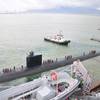by John Hatley, PE GE Marine
NOTE: This is part one of a two-part series on the ABCs of emissions requirements in the marine industry.
Today environmental concerns are at the forefront of the public and represent a major effort by vessel owners to meet compliance standards. Many operators find the elaborate acronyms and various definitions confusing when maneuvering through the variety of regulatory requirements. How to meet the compliance standards in a timely fashion can be at first intimidating until acquiring a basic understanding of emission ABC's.
International and U.S. Standards
Three dominant emission standards are applicable or enforceable for marine diesel engines : MARPOL Annex VI, EPA Marine Tier I, and EPA Marine Tier II. Application of these standards generally depends on a vessel's flag of registry with minor exceptions.
Foreign flag vessels must comply with the International Maritime Organization (IMO) technical code of Annex VI of MARPOL 73/78 Annex VI Regulations (not yet enforced). In addition, the country of registry may invoke additional measures on vessels not trading internationally. This is the case for United States flag vessels that must meet the emission requirements of the U.S. Environmental Protection Agency (EPA) unless granted a foreign trade exemption.
Background
The primary IMO code for pollution reduction is the, "International Convention on the Prevention of Pollution from Ships," also known as MARPOL 73/78. The IMO adopted protocol MARPOL 73/78 on September 27, 1997 although it hasn't yet come into force. Annex VI to this convention specifies in Regulation 13 compliance limits for nitrogen oxides (NOx) but is silent about limits for hydrocarbons (HC), carbon monoxide (CO), or particulate matter (PM). The NOx emissions produced by gas turbines and boilers are significantly lower than diesel engines and therefore these plants are not presently covered in MARPOL Annex VI.
The U.S. EPA is responsible for carrying out section 213 of the Clean Air Act that requires it to set emission standards for non-road engines. The principal EPA rule, "Control of Emissions from Marine Compression-Ignition Engines," was signed on November 23, 1999. This ruling adopts standards for marine compression-ignition engines with rated power at or above 37 kilowatts (kW).
The largest marine engines - those above 30 liters per cylinder - are anticipated but not required by the 1999 EPA rule to comply with MARPOL Annex VI limits. While the 1999 rulemaking did exempt Category 3 marine engines (those over 30 liters per cylinder), the Part 94 rules were amended for a third time in a February 8, 2003 Federal Register Notice to remove that exemption - thereby acknowledging these larger engines compliance under MARPOL standards.
Compliance Ratification
Once ratification of MARPOL Annex VI is achieved, compliance will be mandatory, as the requirements are binding and require global compliance. Otherwise a vessel may forgo essential trading certificates. In order to be ratified, MARPOL Annex requires approvals from a minimum of 15 countries representing more than 50% of the world's merchant ships. Twelve months following final ratification, enforcement will begin.
Ratification affirmation is proceeding and nearly concluded thus far with 12 countries representing 54% of tonnage in approval. Although imminent, the international standards are not currently enforceable because the required number of countries has not been reached. The U.S. government is preparing documents for President Bush to submit Annex VI to the Senate for its advice and consent for ratification.
Although short of the 15 countries needed for ratification, once achieved this mandatory Annex is binding on all countries whether or not they have individually completed formal parliamentary consent.
EPA Marine Tier 1 invokes mandatory compliance with MARPOL Annex VI effective for engines above 2.5-liter displacement per cylinder manufactured on or after January 1, 2004. For U.S. vessels, this means dual certification to both MARPOL Annex VI and EPA Tier 1 requirements.
EPA Marine Tier 2 tightens NOx limits and also includes other pollutants; Total Hydrocarbons (THC), PM, and CO.
John Hatley PE, is a business manager with GE Marine. He can be reached at (206) 605-0604 or by email at [email protected].
Featured videos

Inside the Electrified Truckable Tug

Tracking Foreign Vessels Working in the U.S. Jones Act Market

Inmarsat Enhances Service to Drive Digitalization
Subscribe for
Maritime Reporter E-News
Maritime Reporter E-News is the maritime industry's largest circulation and most authoritative ENews Service, delivered to your Email five times per week









